Click on images to enlarge
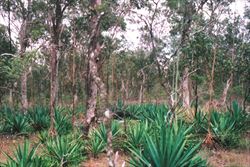
infestation in bushland (Photo: Land Protection, QDNRW)
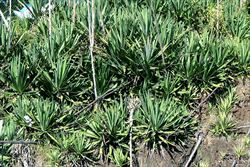
dense infestation on a railway cutting (Photo: Sheldon Navie)
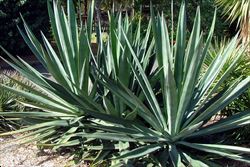
habit (Photo: Sheldon Navie)
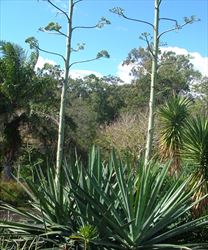
habit in flower (Photo: Sheldon Navie)
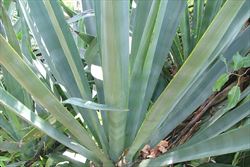
the very large, elongated, fleshy, greyish-green leaves (Photo: Sheldon Navie)
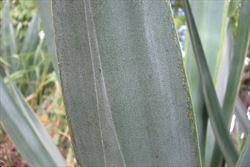
close-up of the leaf showing the lack of prickles on its margins (Photo: Sheldon Navie)
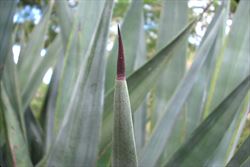
the conical spine at the leaf tip (Photo: Sheldon Navie)
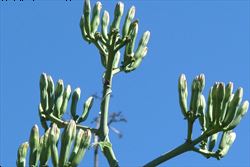
flower buds (Photo: Sheldon Navie)
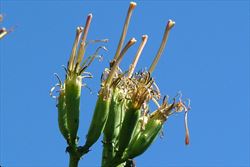
close-up of upright flowers (Photo: Sheldon Navie)
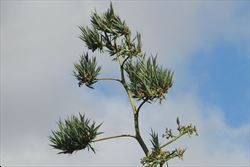
clusters of plantlets on old flowering branches (Photo: Forest and Kim Starr, USGS)
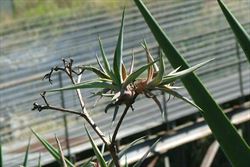
close-up of plantlets on the old flowering branches (Photo: Sheldon Navie)

young plant (Photo: Sheldon Navie)
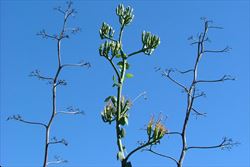
flower cluster and old flowering branches (Photo: Sheldon Navie)
Scientific Name
Agave sisalana Perrine
Family
Agavaceae
Common Names
agave, century plant, hemp plant, mescal, sisal, sisal agave, sisal hemp
Origin
This species is only known from cultivation, but it is thought to have originated in Mexico.
Naturalised Distribution
Naturalised mainly in the coastal districts and offshore islands of eastern Queensland. It was also naturalised on Rottnest Island, off the coast of south-western Western Australia, and is possibly also naturalised in eastern New South Wales. Herbarium records probably underestimate its actual distribution, as this species is difficult to collect and preserve.
Also naturalised overseas in southern Africa, Madagascar, the Caribbean, south-eastern USA (i.e. Florida) and on some Pacific islands (i.e. Fiji, Kiribati, Nauru, Palau and Hawaii).
Notes
Sisal (Agave sisalana) is a succulent plant that is widely cultivated as a garden ornamental and sometimes also grown as a fibre plant. It has become naturalised in a wide variety of habitats, but is mostly found growing in coastal districts and on offshore islands in eastern Australia. This species develops dense infestations which can prevent the regeneration of trees and exclude understorey species in native bushland.
Sisal (Agave sisalana) is regarded as an environmental weed in many parts of Queensland and is listed as a priority environmental weed in at least one Natural Resource Management region in this state. It is currently of most concern in south-eastern Queensland, where it is ranked among the top 200 most invasive plant species, and it appears on numerous local environmental weed lists in this region (e.g. in Burnett Shire, Maryborough City, Cooloola Shire, Redland Shire and Maroochy Shire). It is also listed as one of the 35 most troublesome weed species occurring on sandy beaches and dunes along Queensland's east coast.
This species is regarded as a major weed of Fraser Island, off the coast of south-eastern Queensland, and was deliberately introduced to this island in the latter part of the 19th century. Dense infestations of this species are now present near the Sandy Cape Lighthouse and around the site of the old Bogimbah Creek Mission. The integrity of the Fraser Island World Heritage area could be threatened if this species invades the nearby natural vegetation.
A major infestation of sisal (Agave sisalana) was also recently reported from along Gibbs Creek, near Irvinebank, in northern Queensland. It was forming almost impenetrable thickets at this site and had virtually stopped any form of native plant growth. Sisal (Agave sisalana) is also listed as a high priority weed species in Townsville City, and is of particular concern on Magnetic Island. It is also being targeted for removal from revegetation areas at Balgal Beach and is regarded as a potential environmental pest in Thuringowa City.
Sisal (Agave sisalana) is also listed as a medium priority species in the Mackay Whitsunday region and as an environmental weed in the Burdekin Dry Tropics region in central Queensland. It is declared under local law in Rockhampton City, where small outbreaks are reported along the waterways at the base of Mt Archer National Park, which itself has large infestations of this invasive species.
This species has also been recorded from Rottnest Island, of the Western Australian coast, from where it is thought to have been eradicated. A small population of sisal (Agave sisalana) has also been reported from Bournda National Park in south-eastern New South Wales. It is also reported to be a weed of grasslands and reed-covered hillsides in Fiji and dry rocky sites in Hawaii.

